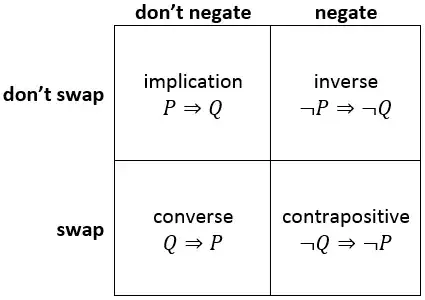I definitely would maintain the logical inverse is useful as a concept. But I think the universe of possible "uses" of the logical inverse is far too broad, plus the definition of "useful" in this context far too hazy, to really get into that here.
Here's a schema which might make it easier to remember:

You can consider these four concepts, as the result of 2 distinct "operations", each of which has 2 possibilities (i.e. "applied" or not): $(1)$ negate the antecedent and the consequent, and $(2)$ swap the antecedent and the consequent. Looking at it this way, we can classify these four concepts, in terms of which operation(s) they break down into:
- Implication: $()$
- Inverse: $(1)$
- Converse: $(2)$
- Contrapositive: $(1, 2)$ or $(2, 1)$
Looking at it this way also, I think, makes much clearer another important connection, which is that the contrapositive is the inverse of the converse, or, equivalently, the converse of the inverse.
In your question also brought up the notion of logical transposition, that is, the equivalence between an implication and its contrapositive - or, symbolically, the fact that $(P \Rightarrow Q) \Leftrightarrow (\neg Q \Rightarrow \neg P)$ is a logical theorem. Transposition is the replacement rule that says you can replace any occurrence of $(P \Rightarrow Q)$ in a predicate with $(\neg Q \Rightarrow \neg P)$, without changing its truth value. Our grid fits this rule into a broader context, as one of three possible things that can happen when you start with an implication in the top left square, and take exactly 2 steps in any (non-diagonal) direction.
- Right + Left corresponds to the inverse of the inverse. The inverse of $(P \Rightarrow Q)$ is $(\neg P \Rightarrow \neg Q)$, and the inverse of $(\neg P \Rightarrow \neg Q)$ is $(\neg\neg P \Rightarrow \neg\neg Q)$ which by the double negation rule $\neg\neg P \Leftrightarrow P$ is equivalent to the original implication, $(P \Rightarrow Q)$.
- Down + Up corresponds to the converse of the converse. The converse of $P \Rightarrow Q$ is $Q \Rightarrow P$, and the converse in turn of $Q \Rightarrow P$ brings us back to $P \Rightarrow Q$, which is exactly the original implication.
- Down + Right (in either order) corresponds to the contrapositive. The rule of logical transposition which I just mentioned earlier says that this, too, is equivalent to the original implication.
I'm sure you've noticed what each of these three possibilities has in common: all of them are logically equivalent to the original implication! Any two applications of "inverse" and "converse", in any order, will result in a predicate that's equivalent to the original implication. You can add "contrapositive" to this paradigm easily, too, by converting it into an inverse of a converse.
So, suppose someone asked you: "Given an implication $R = (P \Rightarrow Q)$, what is the inverse of the converse of the converse of the inverse of the contrapositive of the inverse of $R$?" Whoa, that's a doozy! Fortunately, we can use the 2-step rule to quickly and easily figure it out. Tally up the occurrences of each word, and let $I = ``\text{inverses''} + ``\text{contrapositives''}$ and $C = ``\text{converses''} + ``\text{contrapositives''}$.
- If $I$ and $C$ are both even: then you can cancel out all the inverses and converses in pairs of two. The entire predicate is therefore logically equivalent to the original implication, $(P \Rightarrow Q)$.
- If $I$ and $C$ are both odd: then you can cancel out all but one each of the inverses and converses in pairs of two. The remaining single "inverse" and "converse" combine to make the entire predicate equivalent to the contrapositive. And as the contrapositive, the entire predicate is therefore equivalent to the original implication, $(P \Rightarrow Q)$.
- If $I$ is even but $C$ is odd: then you can cancel out all the inverses and all but one of the converses in pairs of two. The remaining single "converse" means the entire predicate is logically equivalent to the converse, $(Q \Rightarrow P)$.
- If $I$ is odd but $C$ is even: then you can cancel out all but one of the inverses and all the converses in pairs of two. The remaining single "inverse" means the entire predicate is logically equivalent to the inverse, $(\neg P \Rightarrow \neg Q)$.
(Final note: I'm sure there are some technical terms for this type of meta-deduction that I'm not aware of and/or not using here. Please feel free to clarify with comments!)
